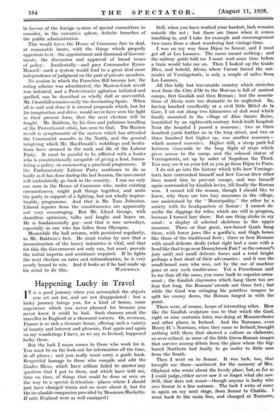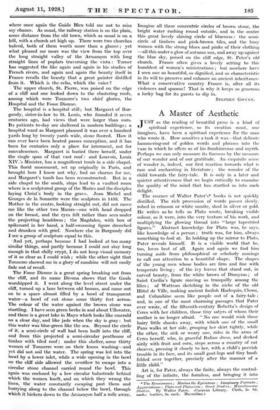Happening Lucky in Travel
1T is a good journey when you accomplish the objects you set out for, and are not disappointed : but a lucky journey brings you, for a kind of bonus, some experience which you never planned for because you never knew it could be had. Such chances await the traveller in England at a thousand corners. Or, overseas, France is so rich a treasure house, offering such a variety of beauty and interest and pleasure, that again and again on my wanderings I have, as we say in Ireland, happened lucky there. But the luck I mean comes to those who work for it. You must be on the look-out for information all the time, in all plices ; and you really must carry a guide book. Respectful homage to those who compile and edit the Guides Bleus, which have seldom failed to answer any question that I put to them, and which have told me, time on time, of things that could be done or seen on the way to a special destination—places where I should just have changed trains and no more about it, but for the invaluable companion provided by Messieurs Hachette. If only England were as well equipped I Still, when you have worked your hardest, luck remains outside the net ; but there are times when it comes tumbling in, and I take for example and encouragement two cases from a short wandering last vintage-time. I was on my way from Dijon to Semur, and I must get off at Les Laumes. The name meant nothing ; and the railway guide told me I must wait some time before a train would take me on. Then I looked up the Guide Bleu, and behold, Alesia, where Caesar forced :the sur- render of Vercingetorix, is only a couple of miles from Les Latunes. All this hilly but traversable country which stretches west from the Cote d'Or to the Morvan is full of ancient camps, first Gaulish and then Roman ; but the associa- tions of Alesia were too dramatic to be neglected. So, having lunched excellently at a civil little -Hotel de la Gare, I set out along two kilometres of dull road 'which finally mounted to the village of Alise Sainte Reine, beautified by an eighteenth-century brick-built hospital. Near the hospital I passed a museum ; two or three hundred yards further on in the long street, and two or three hundred feet higher up, was another museum— which seemed excessive. Higher still, a steep path led between vineyards to the long flight of steps which gives access to the camp, and the colossal statue of Vercingetorix, set up by order of Napoleon the Third. You may see it on your left as you go from Dijon to Paris. I do not go into the history which tells how Vercinge- torix here entrenched himself and how Caesar drew other lines round him to prevent escape, and was himself again surrounded by Gaulish levies, till finally the Roman won. I cannot tell the reason, though I should like to know, why there are two tiny museums in the village, one maintained by the " Municipality," the other by a society with its headquarters at Semur : I cannot de- scribe the diggings for relics which are still in progress, because I turned lazy there. But one thing sticks in my mind : a display, of selected skeletons in the upper museum. Three or four great, raw-boned Gauls hang there, with lower jaws like a gorilla's, and thigh bones like those of the traditional Scot ; three or four Romans with small delicate skulls (what right had a man with a head like that to go near Donnybrook Fair ? as the coroner's jury said) and small delicate bones and a total height perhaps a foot short of their adversaries : and it was the small-boned men who won, not by the use .of machine guns or any such contrivance. Yet a Frenchman said to me that all the same, you come back to superior arma- ment ; the Gaulish claymores which hang there too are four feet long, the Romans' swords not three feet ; but while the Gaul was swinging his pointless weapon to split his enemy down, the Roman lunged in with the point. There were, of course, heaps of interesting relics. How like the Gaulish sculpture was to that which the Gael, eight or nine centuries later, was doing at Monasterboice and other places in Ireland. And the Normans, . even Henry II.'s Normans, when they came to Ireland, brought nothing with them that showed a culture so elaborate, SO over-refined, as some of the little Greco-Roman images that survive among debris from the place where the big- boned Northern had finally to go under to little men from the South. .Then I went on to Semur. It was luck, too, that brought me there—sentiment for the memory of Mrs. Oliphant who wrote about the lovely place, but, so far as I could judge, either never saw it or forgot what she saw. Still, that does not count—though anyone is lucky who sees Semur in a fine autumn. The luck I write of came in again on my next stage, from Semur to Chablis. I went back to the main line, and changed at Tonherre, where once again the Guide Bleu told me not to miss my chance. As usual, the railway station is on the plain, some distance from the old town, which as usual- is on a bill, with a church set high up. There were two churches indeed, both of them worth more than a glance ; yet what pleased me more was the view from the top over the long straight valley of the Armancon with long straight lines of poplars traversing the vista : Turner has suggested the like again and again in his studies of French rivers, and again and again the beauty itself in France recalls the beauty that a great painter distilled from it. Which is the echo, which the voice?
The upper church, St. Pierre, was poised on the edge of a cliff and one looked down to the clustering roofs, among which were Tonnerre's two chief glories, the Hospital and the Fosse Dionne.
- The hospital is a hospital still ; but Margaret of Bur- gundy, sister-in-law to St. Louis, who founded it seven centuries ago, had views that were larger than ours.
Its patients to-day are sheltered in modern buildings ; a hospital ward as Margaret planned it was over a hundred yards long by twenty yards wide, stone floored. How it can ever have been heated passes conception, and it' has been for centuries only a place for interment, not for convalescence. Margaret is buried there herself, under the single span of that vast roof : and Louvois, Louis XIV.'s Minister, has a magnificent tomb in a side chapel.
This florid monument, set up originally in Paris, and brought here I know not why, had no charms for me, and Margaret's tomb has been reconstructed. But in a side chapel to the south, steps lead to a vaulted room where is a sculptured group of the Marks and the disciples laying Christ's body in the grave. Jean Michel and Georges de la Sonnette were the sculptors in 1453. The Mother in the centre, looking straight out, did not move me like the other two Maries—one with head dropped on the breast, and the eyes felt rather than seen under the projecting headdress ; the Magdalen, with box of spikenard in her hand, a- half-swooning figure drenched and• drunken with grief. Nowhere else in Burgundy did I' see a group of sculpture equal to this.
And yet, perhaps because I had looked at too many Similar things, and partly because I could not stay long enough in that chilly crypt, I do not keep visual memory of it so clear as I could wish ; while the other sight that Tonnerre showed me in a glory of sunshine will not easily fade out of recall.
"The Fosse Dionne is a great spring breaking out from the cliff, and its name Divona shows that the Gauls worshipped it. I went along the level street under the cliff, turned up a lane between old houses, and came out on to a space almost filled by a bowl of transparent water—a bowl of cut stone some thirty feet across.
The colour of the water against the brown stone was startling. I have seen green becks in and about Ullswater, and'there is a great lake in Mayo which looks like emerald on a clear day, and like jade when the sky is gray : but this water was blue-green like the sea. Beyond the circle of it, a semi-circle of wall had been built into the cliff, and from this projected a semi-circular penthouse of timber with tiled roof ; under this shelter, some thirty women of Tonnerre were on their knees washing—and yet did not soil the water. The spring was led into the bowl by a lower inlet, while a wide opening in the bowl on the cliff side allowed the overflow to escape into a circular stone channel carried round the bowl. This again was enclosed by a low circular balustrade behind which" the women knelt, and on which they wrung the linen, the water constantly escaping past them and hurrying along to the channel below the bowl, through which it bickers down to the Armancon half a mile away. Imagine all these concentric circles of brown stone, the bright water rushing round outside, and in the centre this great lovely shining circle of blueness : the semi- circle of timbers and pink-brown tiles, and the busy women with the strong blues and pinks of their clothing —all this under a glow of autumn sun, and away up against the blue sky, poised on the cliff edge, St. Peter's old church. France often gives a lovely setting to this humblest of women's ministrations ; but nowhere have I seen one so beautiful, so dignified, and so characteristic in its will to preserve and enhance an ancient inheritance. What a conservative country France is, after all its violences and spasms ! That is why it keeps so generous a lucky bag for its guests to dip in.
STEPHEN GWYNN.





























 Previous page
Previous page